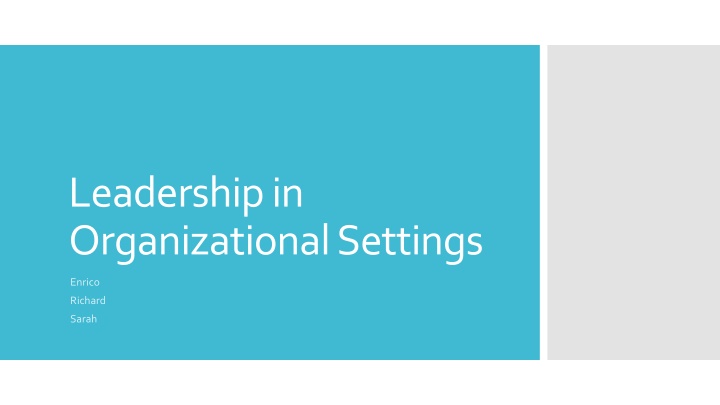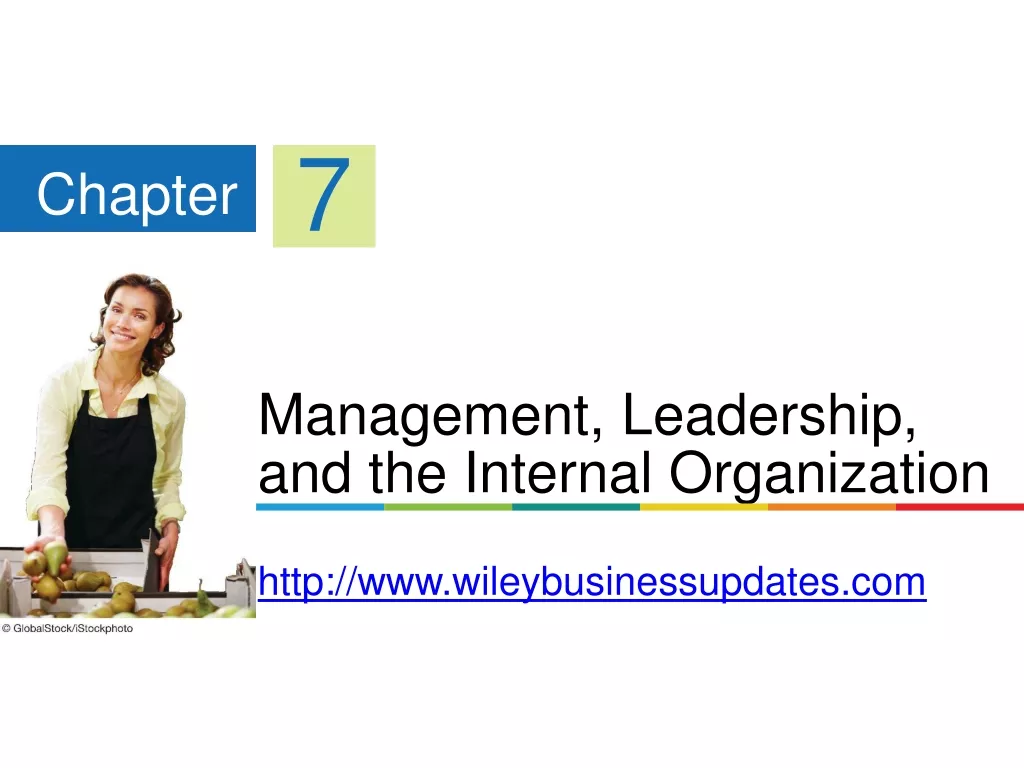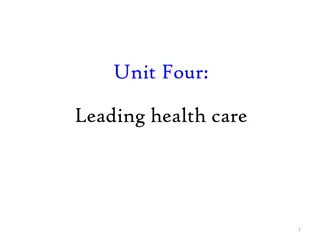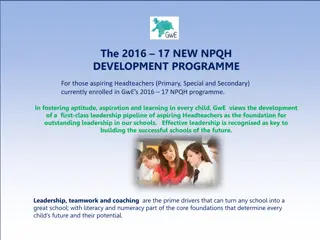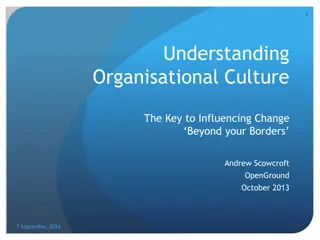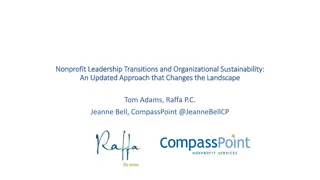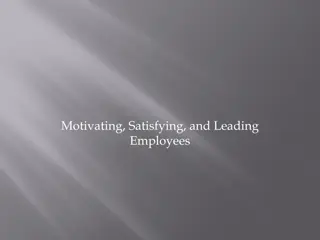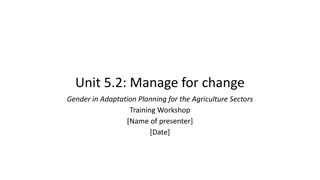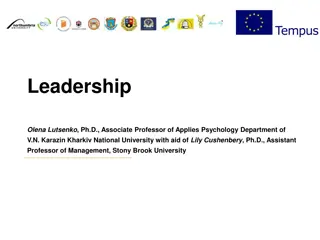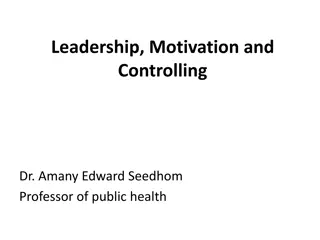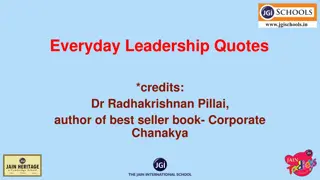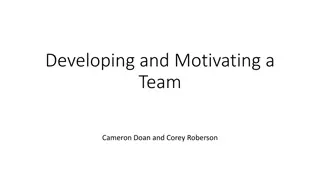Leadership in Organizational Settings - Influencing, Motivating, and Enabling Team Success
Leadership in organizational settings involves influencing, motivating, and enabling others to contribute to the effectiveness and success of their teams and organizations. It encompasses shared leadership, leadership competencies, behavioral perspectives, and contingency theories that shape effective leadership practices. Understanding the importance of personality traits, self-concept, drive, integrity, emotional intelligence, and cognitive abilities in leadership plays a crucial role in guiding leaders towards achieving organizational goals.
Download Presentation

Please find below an Image/Link to download the presentation.
The content on the website is provided AS IS for your information and personal use only. It may not be sold, licensed, or shared on other websites without obtaining consent from the author.If you encounter any issues during the download, it is possible that the publisher has removed the file from their server.
You are allowed to download the files provided on this website for personal or commercial use, subject to the condition that they are used lawfully. All files are the property of their respective owners.
The content on the website is provided AS IS for your information and personal use only. It may not be sold, licensed, or shared on other websites without obtaining consent from the author.
E N D
Presentation Transcript
Leadership in Organizational Settings Enrico Richard Sarah
Mempengaruhi, memotivasi dan memungkinkan orang lain untuk berkontribusi terhadap efektivitas dan keberhasilan organisasi mereka. Leadership
Shared Leadership Pandangan bahwa kepemimpinan didistribusikan bukan ditugaskan untuk satu orang, sehingga orang-orang dalam tim danorganisasimemimpinsatusamalain. secara luas,
Leadership Competency Description Personality The leader s higher levels of extroversion(outgoing, talkative, sociable, and assertive) and conscientiousness (careful, dependable, and self- disciplined). Self-concept The leader s self-beliefs and positive self-evaluation about his or her own leadership skills and ability to achieve objectives. Drive The leader s inner motivation to pursue goals. Competency Perspective of Leadership Integrity The leader s truthfulness and tendency to translate words into deeds, Leadership motivation The leader s need for socialized power to accomplish team or organizational goals. Knowledge of the business The leader s tacit and explicitknowledge about the company s environment, enabling the leader to make more intuitive decisions. Cognitive and practicalintelligence The leader s above-averagecognitive ability to process information (cognitive intelligence) and ability to solve real-world problems by adapting tp, shaping, or selecting appropriate environments (practical intelligence) Emotional intelligence The leader s ability to monitor his or her own and others emotions, doscriminate among them, and use the information to guide his or her thoughts and actions.
Behavioral Perspective of Leadership Choosing Task-versus People Oriented Leadership.
Contingency Perspective of Leadership Based on the idea that the most appropriate leadership style depens on the situation. Most contingency leadership theories assume that effective leaders must be both insightful and flexible.
Path-Goal Theory of Leadership A contingency theory of leadership based on the expectancy theory of motivation that relates several leadership styles to specific employee mendukung Servant leadership = teori dimana pemimpin perusahaan tidak dilihat sebagai orang yang berkuasa dan penuh power, melainkan sang pemimpin mau membantu, melatih, dan memfasilitasi para karyawannya
Path-Goal Leadership Styles 1. Directive 2. Supportive 3. Participative 4. Achievment - oriented
Employee contingencies 1. Skills and Experience 2. Locus of Control
Enviromental Contengcies 1. Task stuctures 2. Team dynamics
Situational Leadership Theory / life-cycle theory of leadership Dikembangkan oleh Paul Hersey dan Ken Blanchard Inti dari teori kepemimpinan situational adalah bahwa gaya kepemimpinan seorang pemimpin akan berbeda-beda, tergantung dari tingkat kesiapan para pengikutnya.
Fiedlers contingency model kelompok yang efektif bergantung pada kesesuaian antara gaya interaksi seorang pemimpin dengan bawahannya serta sejauh mana situasi tersebut menghasilkan kendali dan pengaruh untuk pemimpin tersebut
Leadership Substitutes Theory Teori ini menyatakan bahwa faktor-faktor situasional yang berbeda dapat meningkatkan, menetralisir, atau merubah perilaku pemimpin
Transformational leadership Sebuah gaya kepemimpinan yang menjelaskan bagaimana para pemimpin dapat mengubah tim dengan menciptakan visi dan berkomunikasi dengan bawahan agar mencapai tujuan tertentu.
Transactional Leadership Gaya kepemimpinan yang membantu organisasi mencapai tujuan mereka saat ini, seperti dengan memberi imbalan kepada karyawan yang berprestasi dan memastikan bahwa karyawan telah mendapatkan sumber daya yang dibutuhkan untuk menyelesaikan pekerjaannya.
Charismatic Leadership Pemimpin charismatic biasanya memiliki karisma untuk mengubah perilaku pengikutnya. Biasanya pemimpin ini bisa memposisikan dirinya sebagai pemimpin yang sangat dibutuhkan dan krusial bagi bawahannya.
Build Develop a strategic vision commitment to the vision Element of Transformational Leadership Communicate the vision Model the vision
Implicit Leadership Perspective Implicit leadership theory Merupakan sebuah persepsi mengenai karakteristik dan pengaruh dari seorang pemimpin.
Prototypes of Effective Leaders Implicit Leadership Perspective The Romance of Leadership
Implicit Leadership Perspective Prototype of effective leadership Intelligent High Verbal Skills Fair Good interpersonal Skills Leader Evaluation Prototype matching My boss is a good leader Rating Behaviors (using global impressions) Observed Leadership Behaviors Question: Does your boss have good social skills? Answer: Yes, he s a good leader so he must have good social skills Intelligent High Verbal Skills Fair
Cross-Cultural and Gender Issues in Leadership Gender issues Leadership Cross-cultural
